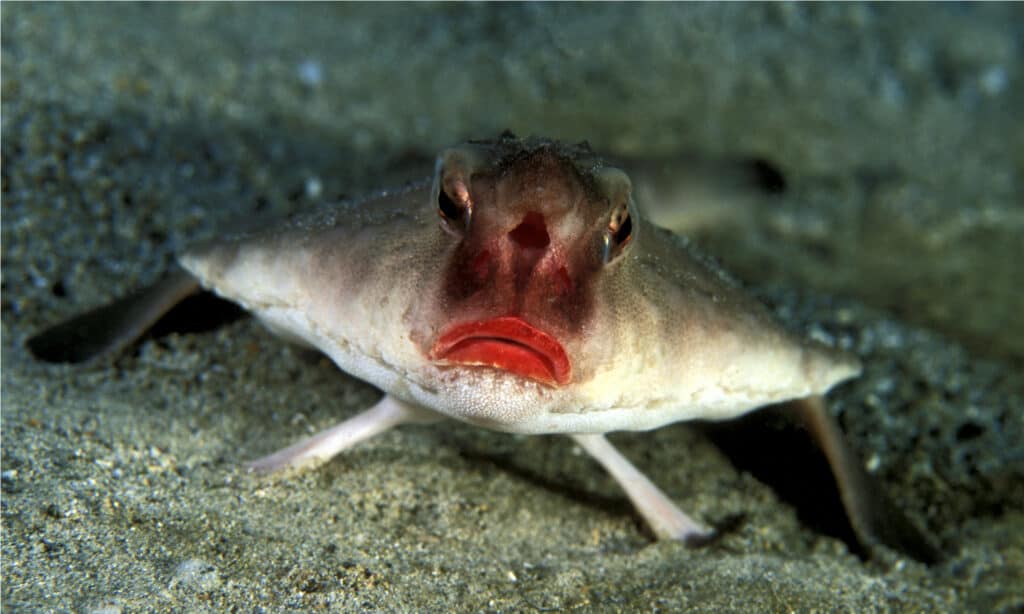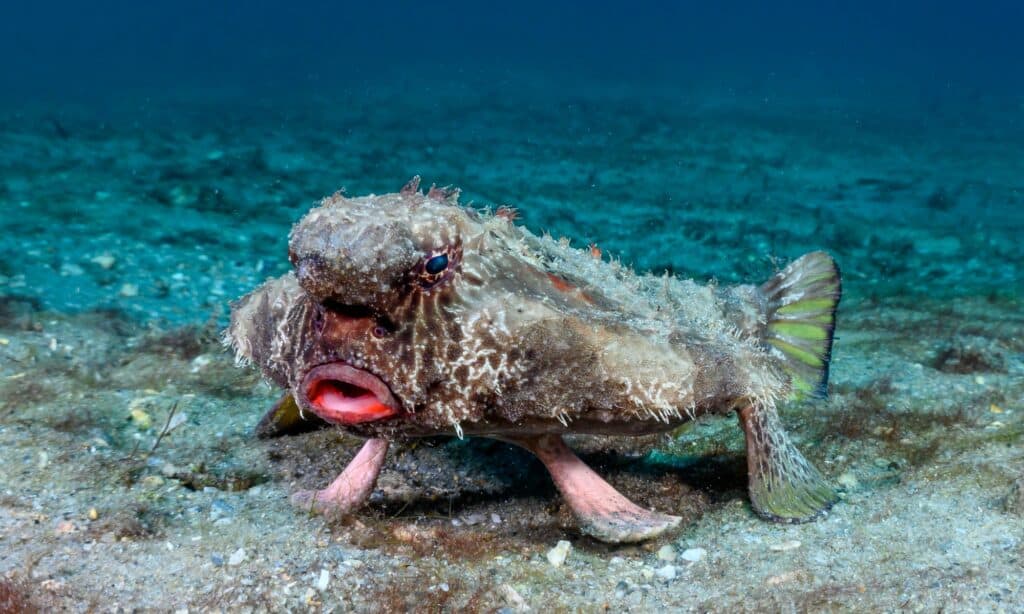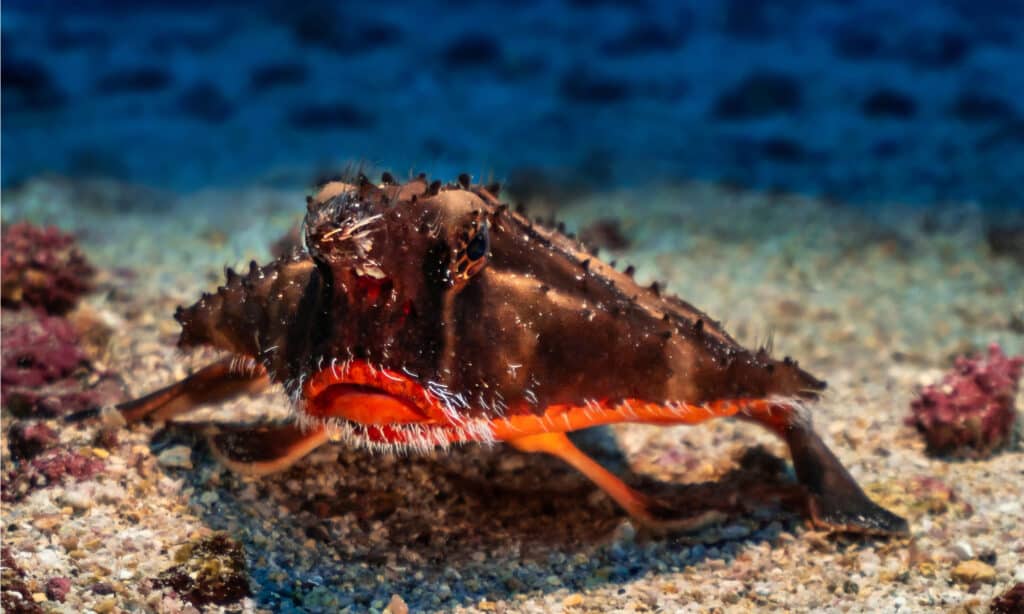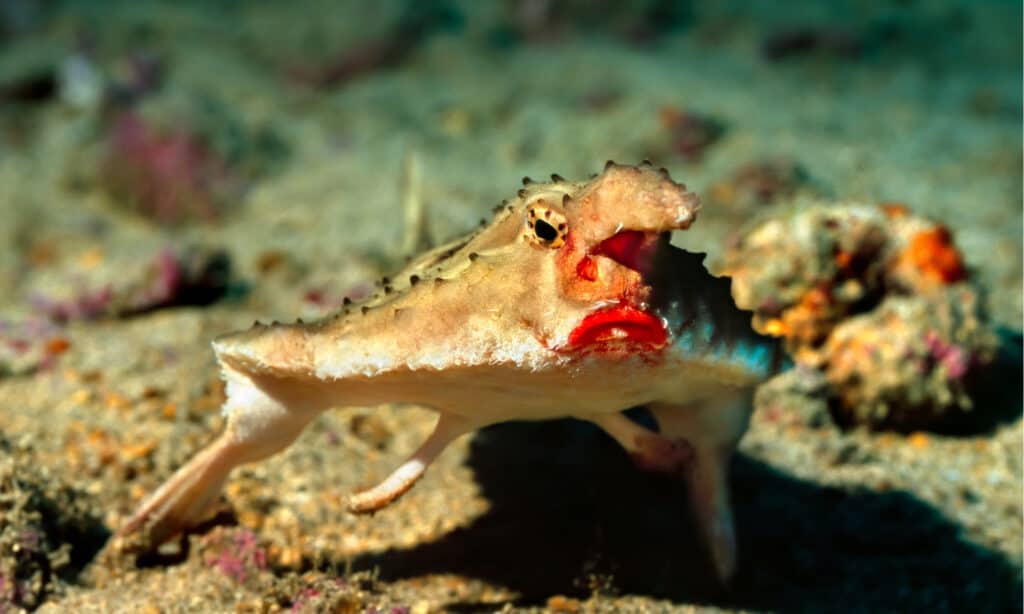Batfish
The batfish has a lure on its head to attract prey
Advertisement
Batfish Scientific Classification
Read our Complete Guide to Classification of Animals.
Batfish Conservation Status
Batfish Facts
- Prey
- Shrimp, crabs, snails, worms, and fish
- Group Behavior
- Solitary
- Fun Fact
- The batfish has a lure on its head to attract prey
- Estimated Population Size
- Unknown
- Biggest Threat
- Climate change
- Most Distinctive Feature
- The flat, rounded head and thin body
- Other Name(s)
- Handfish or seabat
- Gestation Period
- Unknown
- Optimum pH Level
- Unknown
- Predators
- Larger fish
- Diet
- Carnivore
- Type
- Ray-finned fish
- Common Name
- Batfish
- Number Of Species
- 60
View all of the Batfish images!
The batfish has the ability to “walk” along the sandy bottom of the ocean with its fins.
The batfish family is perhaps among the most unusual-looking fish in the world. With their round or arrow-shaped heads and short, narrow bodies, they hardly look like fish at all, but rather some kind of bizarre primordial animal from hundreds of millions of years ago. But in fact, they are a type of modern anglerfish, which have a lure on the head to attract prey. These fish should not be confused with the pinnatus batfish from the genus Platax, which is not related to the anglerfish at all. It belongs to an entirely separate order instead.

3 Batfish Facts
- The batfish pushes itself along the sea floor with its fins. When it requires more speed, its hard tail will dig into the ground and push it farther along. As a result, it can achieve surprisingly fast speeds even without the ability to properly swim through the water.
- Some batfish have tiny hair follicles around their face, which presumably help with sensing its environment.
- Despite their bizarre appearance, the batfish is completely harmless to humans.
Classification and Scientific Name
The scientific name of the batfish family is Ogcocephalidae. This may be derived from the combination of two Greek words: ogkos, which means hooked or curved, and kephalos, which means head. There are currently 60 species recognized within this family. Some examples include the red-lipped batfish, the longnose seabat, and the starry handfish.

Ogcocephalidae is derived two Greek words: ogkos, which means hooked or curved, and kephalos, which means head.
©zaferkizilkaya/Shutterstock.com
Appearance
The batfish has an utterly unique appearance perhaps unlike any other fish in the sea. It is characterized by a rounded or arrow-shaped flat head and a small, thin body (which essentially just looks like a long tail) covered in lumps and spines. The two modified fins on the side of the body are used to walk on the bottom of the sea; otherwise, they are poor swimmers. As a member of the anglerfish order, they are equipped with a fishing pole and false bait just above the mouth. But unlike other examples of anglerfish, this pole can be retracted back into the body at any time. Each species has a unique appearance. For instance, the aptly named red-lipped batfish of the Galapagos has a red mouth and a pointed “nose” (which looks surprisingly human when viewed from the front). This nose is actually just the lure on the head. Most batfish rarely grow larger than 20 inches long.

Batfish have disc-shaped, flattened bodies and pectoral, anal, and pelvic fins that behave like limbs.
©iStock.com/tswinner
Types of Batfish
There are around 60 types of Batfish. These are just a few!
- Red-Lipped Batfish – Ogcocephalus darwini, which comes from the Greek words for “hook” which is ogkos and “head” which is kephalḗ, so it means a fish with a hooked head or a hook on its head. Darwini comes from the famed naturalist Charles Darwin. They can be found on the Galapagos Islands.
- Shortnose Batfish – Ogcocephalus nasutus, can be found in the Caribbean from Florida to Venezuela.
- Roughback Batfish – Ogcocephalus parvus, are found all the way from the Brazilian coast to the North Carolina coast.
History and Evolution
Batfish evolved over time to find food where others could not. As competition in the waters became too much, early ancestors of batfish found more success lower and lower to the ocean floors. They adapted to move quickly and efficiently along lower depths and they actually became poor swimmers overall.
Like other anglerfish, their false “bait” is a part of their body that protrudes from their head and lures in prey. This specific evolution is one more way that they can thrive without having to hunt and swim long distances in search of prey.
Distribution, Population, and Habitat
The batfish is found in tropical or temperate oceans all over the planet. They can live at any depth of the sea, from shallow coasts and river estuaries to the deep ocean. The maximum recorded depth was some 13,000 feet below the surface. Since little is actually known about these fish, the IUCN Red List has not really evaluated their conservation status, but they are thought to be widespread. However, because many of them live among coral reefs (including the red-lipped batfish), climate change and coral bleaching could pose a problem in the future.

The fins of the red-lipped Batfish is not adapted for swimming, so it “walks” along the sea-bed.
©Savva Danylchenko/Shutterstock.com
Predators and Prey
The batfish is a carnivorous animal. It “walks” along the bottom of the seafloor in search of prey to consume.
What eats the batfish?
The batfish has very few predators in the wild except perhaps for larger fish such as sharks. Their hard bodies do provide them with a degree of protection.
What does the batfish eat?
The diet of the batfish consists of crabs, shrimp, snails, worms, and smaller fish. Unlike other types of anglerfish, their lure does not glow. Instead, it secretes a chemical into the water that attracts potential prey.

The diet of batfish consists of crabs, shrimp, snails, worms, and smaller fish.
©Joni Hanebutt/Shutterstock.com
Reproduction and Lifespan
Unfortunately, there is very little information available about the reproductive behavior of the batfish, including their mating season, gestation time, and development. It has been suggested that the red-lipped batfish may sport its stylized look in order to attract a mate. The bright colors of the mouth would presumably signify to a potential mate that it’s healthy and worth reproducing with. However, this theory has never been definitively proven. The lifespan of the red-lipped batfish is thought to be some 12 years in the wild.

The lifespan of the red-lipped batfish is thought to be some 12 years in the wild.
©Joe Dordo Brnobic/Shutterstock.com
Fishing and Cooking
The batfish is not usually caught by people either as a source of food or for the pet trade.
View all 284 animals that start with BBatfish FAQs (Frequently Asked Questions)
Where do batfish live?
The batfish tend to live in warm waters all around the world. They can be found at just about any depth down to 13,000 feet.
What is a batfish?
The batfish is a member of the anglerfish order. This can be deduced from the fact that it uses the lure on the top of the head to attract prey. Otherwise, they look very distinct from other anglerfish with the flat, round head and very thin body. This family should not be confused with other types of species also referred to as batfish, including the genus Platax. One of the more common examples is the species Platax pinnatus. The pinnatus batfish, also known as the pinnate spadefish or the dusky batfish, looks like a standard tropical fish with their smooth, round bodies and fins positioned vertically instead of horizontally. They look nothing like the anglerfish.
How many types of batfish are there?
Currently, there are some 60 recognized species of batfish. They are divided into about 10 different genera.
How big are batfish?
Batfish do not usually grow much larger than 14 inches long. The maximum size is around 20 inches.
What do batfish eat?
The batfish primarily consumes snails, crabs, shrimp, worms, and fish.
Thank you for reading! Have some feedback for us? Contact the AZ Animals editorial team.


















